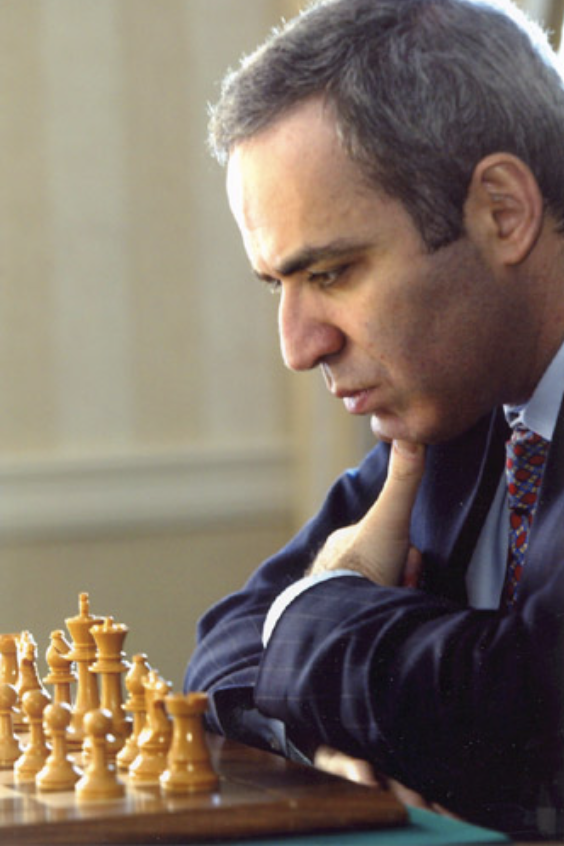As the 20th century came to a close and the 21st century emerged, our species began to expect increasingly more of artificial intelligence. It appeared to many that for the first time in human history, carbon-based intelligence (i.e., human intelligence) might be surpassed by silicon-based intelligence, making us no longer the smartest entities on the planet. In this post, we revisit that “shootout” on the 64 squares of a chessboard. This post is an excerpt from Intelligence: Where we Were, Where we Are, and Where we’re Going.
The 1980’s were a period of frenetic competitions among chess-playing computer programs. In his book Mind Matters, James Hogan observed:
The challengers were appearing from all directions like black-hat contenders for the title of fastest-gun-in-town in a Western movie–and with about comparable life expectancy.
Cray Blitz, a 28,000-line program run on a Cray XMP-48 dominated computer chess at the beginning of the decade, but surrendered in 1985 to a chess-playing program called Hitech that could examine 20,000 configurations per second and look ahead 7 moves. In 1988, Hitech became the first program to win a tournament [rather than a game] against a Grandmaster.
The quest to build a chess-playing program that could defeat the best humans was carried into the 1990’s using IBM’s Deep Thought and its successor Deep Blue. In February 1996, a Western-style showdown between Deep Blue and reigning chess champion Garry Kasparov was scheduled. A prize of $400,000 was to be awarded to the winner and $100,000 to the loser. The media was abuzz asking, “Is the carbon-based intellect superior to the silicon-based intellect?

Deep Blue came equipped with unprecedented chess playing capability, enabling it to evaluate 100 million positions per second. Stored in its memory were the openings of every grand-master game played in the previous century, along with billions of endgame situations which the computer could apply whenever appropriate. At this point, the human side of the equation came only with Kasparov, the reigning human champion.
In what was the largest World Wide Web event to date, an estimated one billion humans tuned in to witness the battle of the titans and resolve, once and for all, whether carbon-based intellect would prevail over the silicon imposter. In game 1, Deep Blue rallied from a defensive position into a conceded defeat by Kasparov after 37 moves. But Kasparov battled back in the second game, grinding to a win on the 73rd move. The third and fourth games were fought to a draw. Most impressively, Kasparov then gained a second wind and shut out Deep Blue on games 5 and 6 to win the tournament 4-2. Though human superiority prevailed, the technology proved relentless in its quest for “top-gun” status.
Emboldened by his success against Deep Blue, Kasparov challenged IBM to a rematch in New York in May 1997. IBM accepted the challenge; Deep Blue arriving for the contest in full battle dress, with even greater processing power and still more memory. It was brute computing power against accumulated human intuition.
Kasparov came out of the gate in game 1 with all synapses firing, and seized victory over Deep Blue in 45 moves. In game 2, Deep Blue avoided a trap, set by Kasparov, to which chess-playing programs had previously fallen prey, and then amazingly countered with a bold “creative” move which signaled Kasparov that his opponent was now really thinking like a human. Disoriented, Kasparov made a move that some chess experts labeled at the time a “serious mistake,” after which he resigned at the 45th move tying the series at 1–1.
Games 3, 4, and 5 were all tied, so both contenders came to the sixth and final game tied at 2½ – 2½. Deep Blue, playing white, opened and Kasparov responded with what is called the Caro-Kann defense. By the eighth move, Deep Blue consulted its massive reference library on the Caro-Kann defense and offered a knight sacrifice that Kasparov accepted. Almost immediately after this knight capture, Kasparov realized his mistake and after 19 moves Deep Blue had emerged victorious, 3½ – 2½, in the battle between carbon-based and silicon-based brains.
In the two decades that followed, the applications of artificial intelligence have continued to proliferate. Voice and face recognition has become increasingly precise, and the imitations of human cognitive processes have often surpassed human capabilities. However, we are discovering that human intelligence is more complex than we first realized and some cognitive skills that we took for granted are difficult to mimmic with algorithms. We’ll investigate some of these ideas later: stay tuned.
